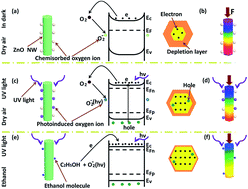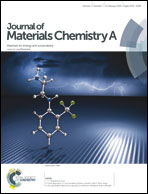Realizing room-temperature self-powered ethanol sensing of ZnO nanowire arrays by combining their piezoelectric, photoelectric and gas sensing characteristics
Abstract
Room-temperature self-powered ethanol sensing has been realized from ZnO nanowire (NW) arrays by combining their piezoelectric, photoelectric and gas sensing characteristics. Under the assistance of UV illumination, the piezoelectric output of ZnO NWs acts not only as a power source, but also as a response signal to ethanol gas at room temperature. Upon exposure to 700 ppm ethanol at room temperature under 67.5 mW cm−2 UV illumination, the piezoelectric output voltage of ZnO NWs (under 34 N compressive forces) decreases from 0.80 V (in air) to 0.12 V and the response is up to 85. The room-temperature reaction between the UV-induced chemisorbed oxygen ions and ethanol molecules increases the carrier density in ZnO NWs, resulting in a strong piezoelectric screening effect and very low piezoelectric output. Our study can stimulate a research trend on designing new gas sensors and investigating new gas sensing mechanisms.


 Please wait while we load your content...
Please wait while we load your content...